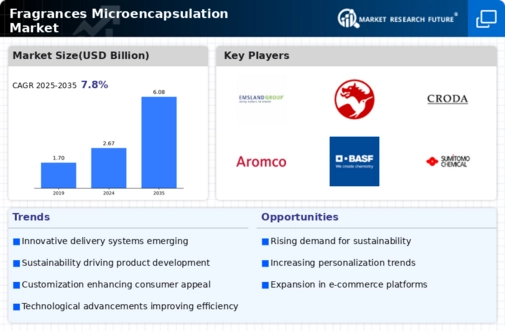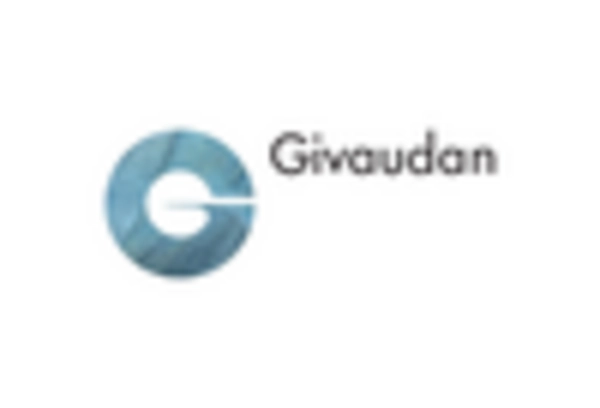Innovations in Delivery Systems
Innovations in delivery systems are significantly influencing the Fragrances Microencapsulation Market. The development of advanced microencapsulation techniques, such as coacervation and spray drying, has enhanced the efficiency of fragrance delivery. These innovations allow for better control over the release rates and stability of fragrances, which is crucial for various applications, including personal care and home products. Market analysis indicates that the adoption of these advanced delivery systems is expected to increase, with a projected market growth rate of around 6% annually. This growth is attributed to the rising demand for high-performance fragrance products that utilize microencapsulation technology to improve user satisfaction and product longevity. Consequently, manufacturers are focusing on research and development to refine these delivery systems, thereby driving the Fragrances Microencapsulation Market forward.
Rising Demand for Long-Lasting Fragrances
The Fragrances Microencapsulation Market is experiencing a notable increase in demand for long-lasting fragrances. Consumers are increasingly seeking products that offer prolonged scent retention, which microencapsulation technology can effectively provide. This technology allows for the gradual release of fragrance over time, enhancing user experience. According to recent data, the market for long-lasting fragrances is projected to grow at a compound annual growth rate of approximately 5.5% over the next five years. This trend is driven by consumer preferences for convenience and value, as products that maintain their scent for extended periods are perceived as more desirable. As a result, manufacturers are investing in microencapsulation techniques to meet this demand, thereby propelling the growth of the Fragrances Microencapsulation Market.
Consumer Preference for Eco-Friendly Products
The Fragrances Microencapsulation Market is witnessing a shift towards eco-friendly products, driven by increasing consumer awareness regarding sustainability. As consumers become more environmentally conscious, there is a growing demand for fragrances that are not only effective but also derived from natural sources. Microencapsulation technology can facilitate the use of biodegradable materials, which aligns with the preferences of eco-conscious consumers. Recent studies suggest that the market for sustainable fragrances is expanding, with an anticipated growth rate of 7% over the next few years. This trend encourages manufacturers to explore sustainable microencapsulation methods, thereby enhancing their product offerings and appealing to a broader audience. As a result, the Fragrances Microencapsulation Market is likely to evolve, focusing on environmentally friendly solutions that meet consumer expectations.
Technological Advancements in Microencapsulation
Technological advancements in microencapsulation are significantly shaping the Fragrances Microencapsulation Market. Innovations such as nanotechnology and advanced polymer materials are enhancing the effectiveness of microencapsulation processes. These advancements allow for improved fragrance stability, controlled release, and enhanced sensory attributes. Market Research Future indicates that the microencapsulation technology segment is expected to grow at a compound annual growth rate of approximately 6.5% in the coming years. This growth is driven by the increasing demand for high-quality fragrance products that utilize cutting-edge technology to deliver superior performance. As a result, manufacturers are investing in research and development to harness these technological advancements, thereby propelling the Fragrances Microencapsulation Market into a new era of innovation.
Expansion of Personal Care and Home Fragrance Sectors
The expansion of personal care and home fragrance sectors is a key driver for the Fragrances Microencapsulation Market. As these sectors continue to grow, the demand for innovative fragrance solutions is increasing. Microencapsulation technology plays a vital role in enhancing the sensory experience of personal care products, such as lotions and shampoos, as well as home fragrance items like candles and diffusers. Market data indicates that the personal care segment is projected to grow at a rate of 5% annually, while the home fragrance market is expected to expand even more rapidly. This growth is attributed to changing consumer lifestyles and preferences for premium products. Consequently, manufacturers are leveraging microencapsulation to create unique fragrance experiences, thereby fueling the growth of the Fragrances Microencapsulation Market.


















Leave a Comment